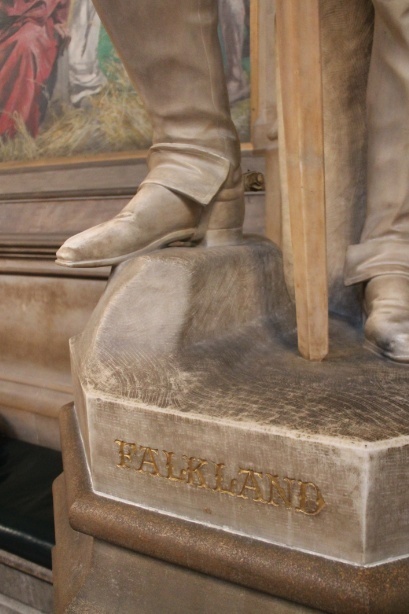
What nerdy Londoner doesn't love a statue anomaly? Whether it's Charles II's creepy mask-face in Soho Square, or the saddle-less, stirrup-less, bootless statue of the Duke of Wellington outside the Royal Exchange — there's nothing quite a like a story secreted in stone (or, indeed, bronze).
Another statue oddity can be found in St Stephen's Hall in the Houses of Parliament — where we find the handsome likeness of Lucius Cary, 2nd Viscount Falkland. The statue was crafted by John Bell in 1845, and made a brief appearance at the Great Exhibition of 1851, before returning to Parliament.

So what's the anomaly then? No, it's not that conspicuous name — although 'Falkland' is indeed related to the Falkland Islands; they were named after the Falkland Sound, itself named after one of his descendants.
Neither is it the differently-hued sword what we're interested in. Although there's a story behind that too; it was broken in 1855 (possible from someone over zealously cleaning it) and replaced. In more recent times, the sword disappeared for a while after an over-zealous visitor accidentally whipped it off the statue. Moral: leave the bloody sword alone.
But it's actually the boot just above the name which we're here for. Or to be precise, the spur on it. Or to be more precise, the lack of spikes on the spur.

As you can see, a large portion has been snapped away. This wasn't done by a cleaner, but a suffragette. As Westminster: A Biography says:
"On 27 April 1909, four women waiting in St Stephen's Hall, supposedly to meet MPs 'suddenly left their seats and by means of thick steel chains concealed under their long cloaks attached themselves to statues. At the same time cries of "Votes for women", "We will have the vote and nothing you can do will stop us" rang through the hall.'
While her three counterparts receptively chained themselves to statues of Walpole and Selden (the fourth suffragette handcuffed a banner to another statue and blew a police whistle for attention), Margery Humes chained herself to the Viscount's spur.
They must have been less fussed with preservation back then: soon after the "mild scene" (as one paper patronisingly put it), the chains were cut with powerful shears, and two spikes from the Viscount's spur were snapped off in the melee. It was never restored, and has become an unintentional symbol of feminism.

Indeed, the poor old Viscount has become something of a symbol for tenacious protest in the Houses of Parliament. In 2009 — the 100th anniversary of that suffragette protest — a group of four climate change protesters glued themselves to the base of the statue.
But while, as a parliamentarian, the Viscount's time was brief (he was killed aged just 32), he continues to be a favourite stop-off on tours.
As for the suffragettes, their struggles are remembered in two windows in St Stephen's Hall — one, a piece by Shona McInnes, which includes a depiction of handcuffs, and another, this 2016 light sculpture above the hall's entrance:





